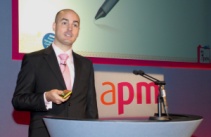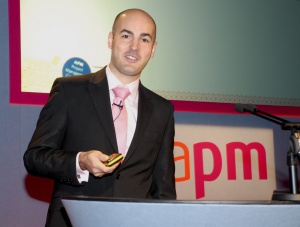The Art of Presenting
When I found out in August that I would be presenting my paper on “The Project Management Mid-life Crisis” at the 2008 APM Conference I was delighted. However this initial delight quickly turned into a stark  question: how could I deliver my complex message simply and with maximum impact?
question: how could I deliver my complex message simply and with maximum impact?
I am no stranger to giving presentations. In fact, at work I have a reputation for being pretty good at them. However on this occasion I wanted to do something a little bit special. In trying to decide how I could do that I came across some fantastic resources on the Internet and a video that would forever change my idea of what constitutes a “great presentation”. I also discovered that the divide between good and truly great presentations can be a hard one to cross.
Everything I have learned since August came from three places:
1. The Excellent Blog of Benjamin Ellis
I had already prepared a set of slides and decided roughly what I was going to say before I found a post by Benjamin entitled Larry Lessig – Copyright and Great Presenting. As soon as I watched the video of Larry Lessig presenting on How Creativity is Being Strangled by the Law I realised that I still had massive room for improvement: I needed to work on exactly what I was going to say and then make the PowerPoint slides back this up visually.
I read many of Benjamin’s other postings on presentations, all of which were well worth the time invested in doing so. I recommend that anyone reads the following:
- A Presentation Lesson From Al Gore
- Preparing to Present – A Check List for Presenting at a Conference or Large Event
- 10 Tips for Better PowerPoint
- 10 Things Not To Do In Business PowerPoint Presentations
2. Alex S. Brown’s Presentations
I listened to a number of Alex S. Brown’s presentations about project management that he makes available on his website. The key lessons that I took away were the importance of humour and of getting the audience involved. That is why my presentation began with two questions which the audience could respond to with a show of hands. It is also why my slides included stills from The Office and Absolutely Fabulous.
3. The Patience of my Girlfriend
Once I had re-drafted my slides and practiced alone many times I unleashed the results on my girlfriend. She works in education and knows a thing or two about how to get a message across clearly (to a sometimes unreceptive audience!). The first time I presented to her we identified numerous areas for improvement and I set about re-drafting the entire presentation again. This process was repeated several times until my long-suffering other half could almost recite the entire presentation better than I could!
Was it worth it?
Without doubt there are pitfalls to the approach I ended up taking. When the organisers of the conference first saw that I had prepared 120 slides for a 20 minute talk they were horrified and promptly suggested I cut down to no more than 20. It took quite some persuasion before they changed their minds.
Another issue is that to be effective you have to know exactly what you are going to say and advance the slides at exactly the correct moment. This takes some practice and also makes you reliant on technology. In fact, I had a small panic when, a week before the conference, I was led to believe that someone else would be advancing the slides on my behalf. Fortunately on the day itself I was given a small remote control so that I could advance them myself. Phew!
Pitfalls aside, I received a lot of very positive feedback from conference delegates. One described my talk as “the most useful so far”. Others said that it had been “entertaining” or that they had “liked the use of visuals”.
More importantly, by trying to do something out of the ordinary, I have learned more about effective presentations over the last few months than ever before. Expect some follow up posts with hints and tips of my own very soon!
Book Review: Ready for Anything
Not all that long ago I read David Allen’s excellent book on personal organisation Getting Things Done (which I also reviewed in this post). Ready for Anything is a follow up to this and consists of a collection of 52 short essays, each of which talks philosophically about the techniques he described in his previous book.
It is a relatively short book and I finished it in what felt like no time at all (always a good sign). David Allen’s writing style is enjoyable to read and the book is littered with wonderful quotations.
I don’t think this book would be very meaningful unless you have already read Getting Things Done. In fact, I felt that this book contained very little new information at all. This led me to wonder whether there was really any point to reading it? Was I just participating in some kind of GTD masturbation: good fun but hardly fruitful? Read more »
APM Conference Photos and Blog
Photos from the 2008 APM conference have been uploaded here. The APM have also setup a conference blog which seems to include quickly written summaries of each presentation together with links so that you can download the slides. My contribution is described here (although most of my slides are missing).
As you can see, I managed to put on a cheesy grin for both of the occasions that the official photographer caught me with his camera:
Great Websites for Project Managers
In the paper that I recently presented at the Association for Project Management (APM) conference I included a section that listed useful and interesting websites related to project management. I don’t often publish lists like this on my blog but today I’m going to make an exception! These are all sites that I visit regularly and I feel they offer useful and/or interesting viewpoints. I thoroughly recommend that you take a look and consider adding some or all of them to your RSS reader of choice. Read more »
Thoughts on The Core
Back in June when I interviewed Jim McCarthy he was keen to tell me about The Core. So keen, in fact, that I posted a follow-up to that interview devoted purely to Jim’s story of what The Core is and how it evolved.
The Core is an intriguing idea. It is a document that attempts to define an optimal way for members of a team to interact. The document is similar in style to documents that describe technical protocols like TCP/IP and HTTP. However this isn’t a document focussed on technology but rather on how people should behave and interact in order to achieve the best results possible. Read more »
APM Conference: Day 2
I attended the second day of the APM conference on Thursday 30th October. It was another full on day with an awful lot of interesting speakers providing a great deal of food for thought.
Nigel Smith, Chief Executive of the Office of Government Commerce (OGC), presented an opening keynote speech in which he talked about the purpose of the OGC and the areas that they are looking to improve.
After a break for coffee I attended a session on sustainability. This was kicked off by Penny Pullan of Making Projects Work. Penny gave some really insightful tips for how to decide when to use conference calls instead of face to face meetings. Penny then went on to talk about the skills and techniques that are required to make conference calls effective. I couldn’t help but feel that a lot of these tips applied equally well to in-person meetings. I must also add that when Penny (and members of the audience) described day-long meetings I was reminded of my personal view that the best meetings are short. Following Penny’s talk Adrian Pyne talked about sustainability from a programme management perspective.
After another short break it was time for two keynote speeches from Sir David Normington (Permanent Secretary, Home Office) and Jonathan Simcock (Executive Director, OGC). Sir David Normington shared a list of six “non-negotiables” for successful projects which I think are worth repeating here: Read more »
 Comments (2)
Comments (2)